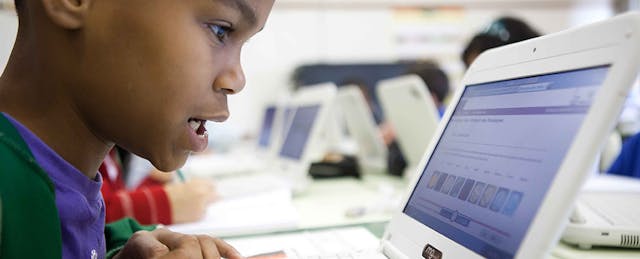A second grade teacher spends part of her weekend planning classes for the coming week. Her students want to learn about numbers and, as she promised, she will let them play with an online game that teach the basics of addition. She makes sure to charge the laptops she requested.
Monday comes. The kids arrived excited to hop online. But the devices cannot maintain a steady connection after dozens of attempts. When they do connect, the signal is so weak that the game does not load properly. What was supposed to be an engaging class has now left students and teachers frustrated.
The scene above is a familiar one for teachers across the world—and especially those who teach in Brazil, where only 43% of schools have access to broadband. Don’t let that number fool you—the government currently defines broadband access as a 2 Mbps connection—for the entire school. Forget emails; that’s barely enough for administrative tasks like maintaining attendance records.

However, several Brazilian organizations, led by the Lemann Foundation, are banding together to boost Internet speeds in the country’s 150,000 K-12 schools.
Founded by Brazilian beverage king Jorge Paulo Lemann, the foundation supports a range of digital learning efforts, including incubating edtech startups and bringing tools like Khan Academy to schools. It also organizes study trips and conferences in the United States. It was at a March gathering at Yale where the foundation invited Evan Marwell, founder of EducationSuperHighway, to speak to Brazilian administrators. Inspired by his work in raising awareness of broadband in US schools, the foundation invited Marwell to Brazil to share his work.
Marwell offered advice, research and strategic recommendations on how replicate his work in Brazil. “We shared our know-how and the technology to measure Internet connection in schools,” said the EducationSuperhighway chief executive and founder.
Two other organizations have also joined the Lemann Foundation’s efforts: Inspirare, a nonprofit that regularly reports on education technology, primarily through its website, Porvir, and ITS, a think tank that conducts research on Internet access and regulatory policies.
“When we were implementing Khan Academy in classrooms, we found it was hard to rely on the school Internet connection,” says Daniela Caldeirinha, project coordinator at Lemann Foundation, which translated Khan Academy videos to Portuguese and trained teachers on using it. “We needed to understand the problem of connectivity in Brazilian public schools.”
The first task undertaken by the trio of organizations was to set feasible goals specifying what Internet speeds each school should have, and estimate how much these efforts would cost the government. These numbers were presented in a report ( available in Portuguese) in August and has been discussed by the Brazilian administrators ever since.
The speed goals vary depending on the size of the school, but there are two major milestones: By 2020, each school should be able to provide anywhere between 100 Mbps and 500 Mbps connection to support digital learning in computer labs. By 2025, the goal is to make sure every classroom is properly equipped for online learning with 200 Mbps to 1 Gbps. To meet these targets, the report estimates the government will have to invest R$15 billion ($3.75 billion).
Today, the typical Brazilian public school serves between 200 and 499 students and is equipped with a 2 Mbps connection. By 2025, the goal is to increase the speed by a hundred-folds.
The graphic below shows the different milestones that the three largest groups of Brazilian public schools—which enroll over 87% of Brazilian students—are expected to achieve by 2018, 2020 and 2025. The Internet connectivity speed goals per student consider the maximum enrollment of each group of schools (499, 999 and 1,500 students, respectively).
In August, another organization, Nossas Cidades, joined the effort and helped to launch a campaign “ Internet na Escola” (“Internet at School”), which offered a gamified tool to challenge Brazilian citizens to take three actions. The first: sending a message to the president requesting better Internet for Brazilian public schools; over 25,000 messages have been sent so far. The second task asked schools to take an Internet speed test (exactly what EducationSuperhighway did in the US two years ago) and share the result on social media. About 30,000 tests have been done so far.
Finally, schools were encouraged to organize a “Connectivity Day” to engage the local community and raise awareness of the importance of online learning. The first took place on October 23; another one is slated for November 30.

Today, Internet access is a prerequisite for a 21st century education. These multi-pronged efforts in Brazil are proof that there is plenty of demand from learners and teachers, and that regardless of socioeconomic factors, foundations and governments have a clear role to play. Much work remains to be done in Brazil—where 70,500 public schools do not have any access to the Internet. But setting clear goals and getting buy-in from important stakeholders is a first step.


